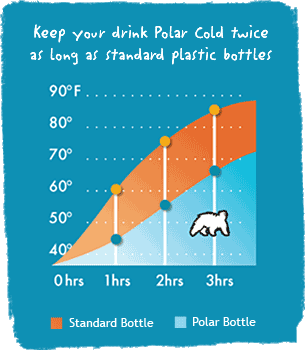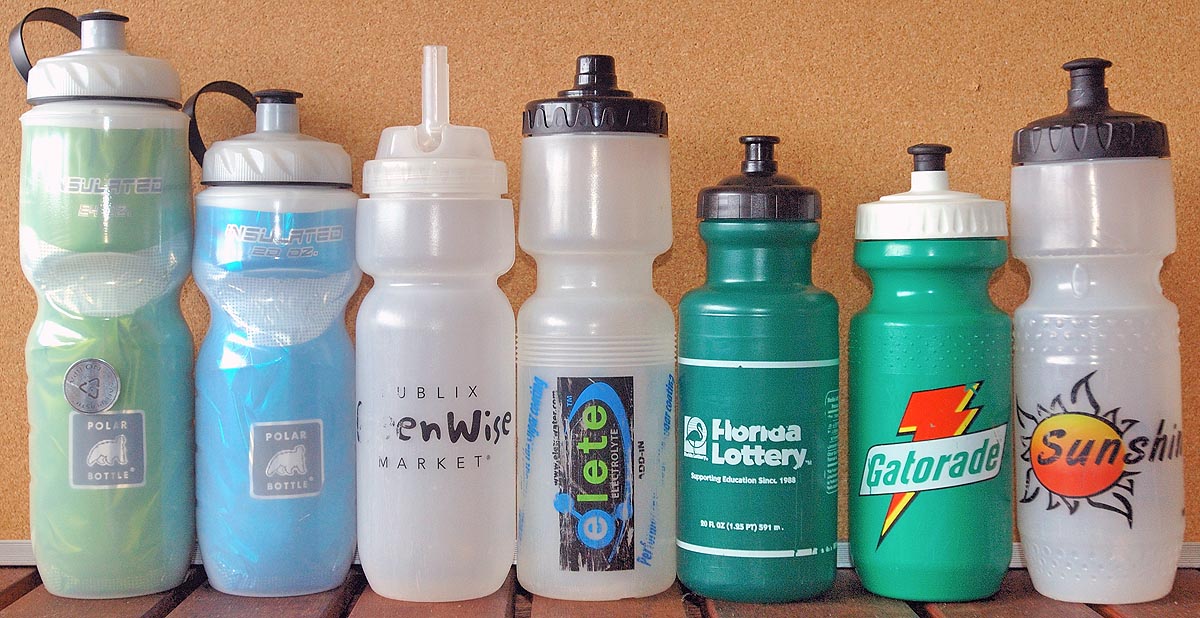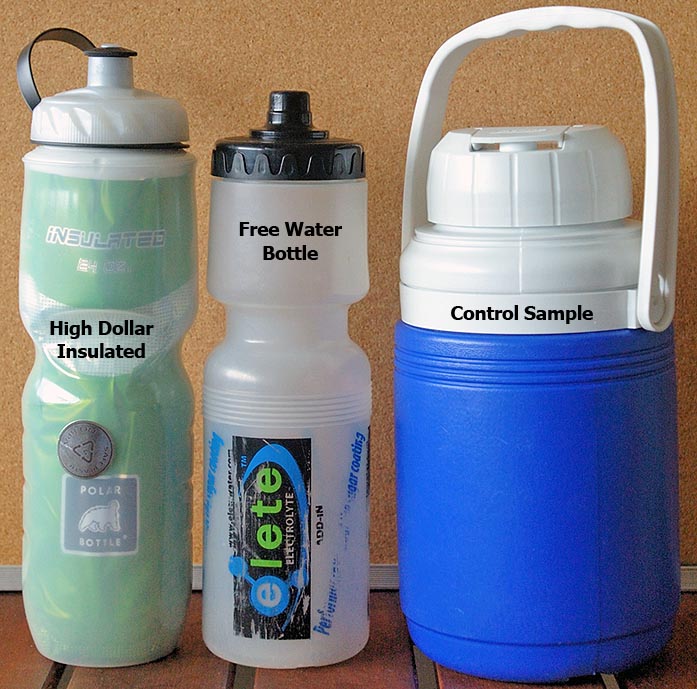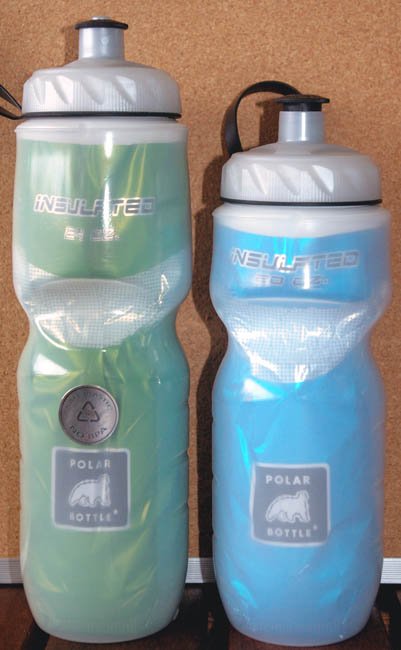Today, my cycling friends, I’ll be discussing the difference between insulated water bottles and uninsulated water bottles. I’ve done extensive testing and am ready to present my results.
If you’re the lazy type, look at the pretty chart (shamelessly borrowed) below and then buy a BPA-free 24-ounce Polar Bottle.
Why do you need cold water? Or water at all?
 It is hot.
It is hot.
I realize that South Florida hot isn’t the same as Arizona hot or Africa hot but it is still pretty darn hot. Add in our world famous, not available in stores, humidity and bike riding is punishing. Keeping well hydrated is absolutely necessary, not just to maintain performance but for survival.
With an uninsulated bottle, water reaches air temperature in less than half an hour on my bike.
I used to ride with an iced-up Camelbak and there was usually still ice in the bag four or five hours later. Yummy! It worked great but I never liked the heavy weight and the massive reduction of air flow across my back.
Freeze Water Bottles Overnight
For the last two years, I have been freezing my water bottles overnight 3/4 full then putting cold water on top right before I leave the house. A large, solid chunk of ice kept the bottle cold about twice as long as did ice cubes.
Even then, that just means cool water for an hour.
My normal Saturday morning group ride is 31 miles and we are out there for an hour and a half. Not even to the turn around point, my water is 85 degrees. Yeah, it’ll keep you hydrated but it is not at a temperature which would encourage you to drink.
You want me to spend how much on a water bottle?!?!
Over the years, I have amassed quite a collection of free water bottles…
Just about every event I do, there’s a free water bottle available. I bet I have 20 of them in the garage. The low end bottles have tops that sometime leak. The higher end bottles are acceptable in every way shape or form with the exception that they don’t keep the water cool.
Did I mention they are free? Until a couple weeks ago, I had never actually paid for a water bottle. It seems almost seedy, maybe reckless, to pay for a water bottle. It would be as though I were lighting my BBQ grill with $10 bills.
Hello, my name is Matt and I paid about $10 for an insulated water bottle.
So, do insulated water bottles really work?
Let’s meet our contestants…
- 24-ounce Polar Bottle Insulated Sport Bottle
- 24-ounce free water bottle
- 32-ounce old-school thermos (the experiment’s control sample)
I filled the three containers to the right with water and froze them overnight. The next day, I sat in my back yard next to the kiddy pool with a beer and proceeded to conduct research. The ambient air temperature rose from hot (87 degrees) to really hot (91 degrees) during the testing. The sky was mostly sunny and the bottles were placed in the direct sun.
Ever 15 minutes, I stuck a thermometer in each vessel and recorded the temperature. At the end of 45 minutes, the free water bottle was devoid of ice. The control sample thermos was still mostly ice and the insulated water bottle was still about 70% ice.
As I was sitting by the pool reading the latest copy of Adventure Cycling, it occurred to me that a static test might not be the best way to develop a metric. While on the bike, wind would be going by the bottles. If I did the test again (which I won’t because I’d rather be riding than testing), I’d stick a fan in front of the bottles to simulate a more bike-like experience.
After two hours, the control sample was still 80% solid ice. The free bottle was the same temperature as the air — about 91 degrees. The water in the insulated bottle was 68 degrees even though the ice was all gone.
At the end of three hours, I was bored. The insulated water bottle was still below the air temperature but not by much. The control sample still had a chunk of ice floating around. The uninsulated water bottle was still hot.
I killed an afternoon to determine what we already know so you wouldn’t have to: insulation works.
What about Bisphenol A (BPA) toxicity?
 We’re all going to die, right?
We’re all going to die, right?
My friend is a big brain scientist with The Scripps Research Institute. His wife threw away all their kids’ sippy cups because Bisphenol A (BPA) kills half of all rats which are exposed to more than 3,250 mg/kg of BPA. He thinks she is nuts. Since he has been featured on NPR and she hasn’t, I’m inclined to believe him.
If you don’t believe him, check out what the FDA has to say about BPA.
The insulated water bottle from Polar Bottle doesn’t have BPAs so it is as safe as you can get within the bounds of the current media panic. Friend’s wife replaced her sippy cups with Polar Bottles. So, even the most paranoid amongst us should be happy.
Will the Polar Bottle fit my bicycle’s bottle cage?
On a normal bike, yes. Either the 24-ounce model or the 20-ounce model
will fit without any problems.
My wife is short (5’4″) and her bike’s diamond frame doesn’t have much room. So, I bought myself two 24-ounce bottles and I bought two 20-ounce bottles for her bike. There is room on her bike’s angled tube for the 24-ounce bottle but the 24-ounce bottle won’t fit in the upright cage. She is limited to the 20-ounce bottle in the upright position.
Anything else I should know?
They come in a bunch of colors. My water bottle matches my helmet. I’m too cute for words.
Insulated water bottles are about eight million times heavier than regular bottles. Weight weenies beware!
I’m sure there are folks other than Polar Bottle making insulated bike bottles. I just haven’t found them. If you know of a Polar competitor, let me know in the comments below.
If you’re riding more than three hours, even these insulated bottles aren’t going to keep your water cool. Check out my father’s review of the CamelBak M.U.L.E.. As much as I hate the weight and lack of airflow when using a CamelBak, when I did my cross-Florida century ride in last 2007, I rode with the bag on my back. It really was the only way to make it across the state.
Should you have any questions, please let me know.
—Matt




I’ve been using the Polar bottles for at least five or six years. Like you, I freeze mine so they melt over time.
I also tend to use a 50% water, 50% sports drink mix because I get tired of drinking straight water out of the Camelbak after a while.
They’ve redesigned the bottles over the years. I don’t think some of the early ones had as many threads in the screwtop and they’d leak from time to time. I haven’t had that problem with the new ones.
(And, I hate to say, “I told you so” about insulated bottles since you made fun of mine.)
(OK, I DON’T hate to tell you “I told you so.”)
DOD (Dear Old Dad)
Seriously?
Cold stuff in your water bottles? I don’t get it. I pour room temperature water into my bottles and hit the miles.
I figure, if warm tea was good enough for the Chinese when they were building the railroads then it has proven itself to do the job.
Cold drinks….I just don’t get it.
Doc5.5,
As I recall, you’re also the guy who used to ride with an old-fashioned fishing bobble in your water bottle so you would have something to amuse you while you were riding.
I’m not sure how much stock I’m going to put in your theories.
Besides, all of those railroad workers are dead now. Is there any connection between that and their consumption of hot tea?
Thanks for the amusing blog post – it answered my questions perfectly! In Hotlanta, we also get a little toasty in the summer. But I’m not putting water in the Polar I’m going to buy this afternoon.
I don’t mind room temp water, hot water left in the car all day. I could care less. Bring it.
The thing is, I’m actually ALLERGIC to sports drinks. (I know, wtf, right?) but I found a substitute that does electrolyte replacement: coconut water. The problem with coconut water is that the instant it gets above “chilled” it is disgusting. Let’s just say I’d rather drink my boyfriend’s post-workout foot bath.
So, a 4-hour ride going 50 miles? Either I’m out of coconut water because I drank it all while it was tasty, or I’m having to stop for a lot of snacks. (Which annoys the buddies). Training for my 1st century is tough enough without engineering difficulties with my “sports drink”.
Alicia, take two bottles. Freeze one bottle solid and freeze the other one half full then fill the rest up. It really does work.
If you like coconut water, have you tried cream of coconut? It is basically sweetened coconut water. It’s thicker but tastes so much better than plain coconut water. It is used in a lot of mixed drinks. Obviously, you wouldn’t full you water bottle with cream of coconut, but it might be good to flavor regular water.
Good luck on the century. Let us know how you do.
Cheers,
Matt
I have been thoroughly entertained by this blog. I was googling insulated water bottles because I need pink to match my bike and my clothes. My bike is silver with just a touch of pink. I didn’t want ya’ll to think it was solid pink! Anyway I found this site first and I agree with the polar bottles. That is what I use and I live in Texas and I have ice in it for quite a while.
Miz Wendy, Mam,
Stop by any time you need to be entertained, enlightened or otherwise mystified. We don’t promise correct answers, just answers.
Texas, huh? I used to go to Dallas for Nortel training quite a bit.
As I recall, you Texans are so snow-averse that somebody can throw an ice cube out the window on the 4th of July and it’ll back up the Interstate for three hours.
I tried Polar and Camelbak insukated water bottles. Both failed to have 3 ice cubes after three hours inside house 68 degrees, I bought a Froogoo straw bottler 12 oz. from Target and it worked in Egypt (90 Degrees) ice still in bottle after 4 hours.
can’t find larger version. Looking now at Good Life.
I only really drink cold drinks and I like them to stay cold. They never do, and drinking lukewarm water is just not nice. Okay so maybe it does the job but colder liquid is always more refreshing.
I live in Phoenix, AZ and volunteer at the Phoenix Zoo. During the summer. 100 degrees on a GOOD day. Polar bottles keep my water at 80ish while the kid’s cheepo water bottles quickly heat up to the hundreds. I love me my polars :)
Interestingly, when I lived in Africa I was surprised that they thought that cold water was very unhealthy when the weather was hot and physical exertion was was to be engaged in. Cold water? They would look at you with a kind of calm patient pity while they explain. Years later my mother in law who was from malaysia , with the same sort of insane heat, espoused the same idea. Drink something warm or better … hot, and it will keep you comfortable or alive much longer.
I have to admit that I find hot water from a bottler awful (but tolerable) … but I do admit that it is probably better for your body when your body is operating under the stress of heat.
I mention this because it seems incongruent to me that if someone goes out on a bike trip in the heat, an intrinsically uncomfortable task, it seems strange to get hung up on good taste over what is good for your body. Why not just drive a winabago with a fridge and be done? :)